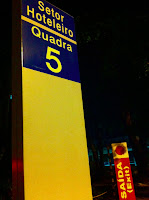Airports. Whether you’re in Atlanta or Paris,
Rio or Cairo... the feeling is somehow always the same: a feeling of
temporality, impermanence and artificiality. You are there, obviously en route
to somewhere else, it is not a place to lay roots or experience the intricacies
of the city at hand, but a place to get in and get out, a contradiction of infinite
cultures and just as many languages, somehow devoid of feeling.
 Brasilia is an airport city, the type
of city that somehow makes your feel like you could be anywhere in the world,
but certainly not in the heart of Brazil... a country dripping with vitality,
sweating samba and sex from every one of its pours. Brazil teases and whispers,
“Você está no brasil agora gringa”.. but Brasilia is flaccid, unassuming, and altogether
monotonous.
Brasilia is an airport city, the type
of city that somehow makes your feel like you could be anywhere in the world,
but certainly not in the heart of Brazil... a country dripping with vitality,
sweating samba and sex from every one of its pours. Brazil teases and whispers,
“Você está no brasil agora gringa”.. but Brasilia is flaccid, unassuming, and altogether
monotonous.
So, why is the alleged heart of this
country nearly opposite in every way possible of its vivid surroundings? Well,
for one thing… it has only existed for 53 years. From 1763-1960, my beloved Rio
was the capital of Brazil... but then the country decided that a more neutral, more
geographically central, less resource-rich location was infinitely more appropriate
for the nation’s capital. Ipso-facto, they designed Brasilia and called it “Plano Piloto” The pilot plan... as if
they knew this was a precarious experiment. “They” being Lúcio Costa as
the principal urban planner, and Oscar Niemeyer as the lead designer.
53 years later, the result is a city-sized-airport. The streets have no names but instead or carved out in series of rigid letters and numbers spread amongst such rigid zoning, that the coffee shops are afraid to be caught in the ministerial blocks. The buildings are a Pleasantville pattern of one cookie cutter office after another, with the occasional eerie post-modern monster of a national monument awkwardly crouching between them. And the beige paper flowers sold on
the street corners are little more than scentless metaphors for the city that silently
hawks them.
Critics of the city (and there are
MANY) say that the city went awry when Costa and Niemeyer designed for space
rather than humanity…what is a city if not designed for humanity?
Robert Hughes, put it bluntly when he
said, “Nothing dates faster than people's fantasies about the future. This is
what you get when you design for political aspirations rather than real human
needs. You get miles of jerry-built platonic nowhere infested
with Volkswagens. This, one may fervently hope, is the last experiment of
its kind. The utopian buck stops here.”
Luckily, the “utopian buck” can stop
wherever the hell it wants because I found a slice of heaven 20 minutes outside
the vast expanse of identical ministries and whitewash pavement. I found
Kantunta, or so the mansion is called by the 8 fabulous people whom live there.
In a stroke of sorte, my Amazonian roommate told me of a friend she had in
Brasilia who somehow always had a spare bedroom. Not so surprising when you
live in a house of 12 bedrooms, 6 bathrooms, painted perfectly on the north
side of Brasilia’s largest body of water. To make the situation even sillier,
more than half of the house’s inhabitants are incredible 20-30 something’s who
happen to work in my field of research, and those that don’t are making
documentaries about indigenous livelihoods and social unrest in the north. The
conversation, needless to say, is both useful and fascinating.
Thanks universe.

































